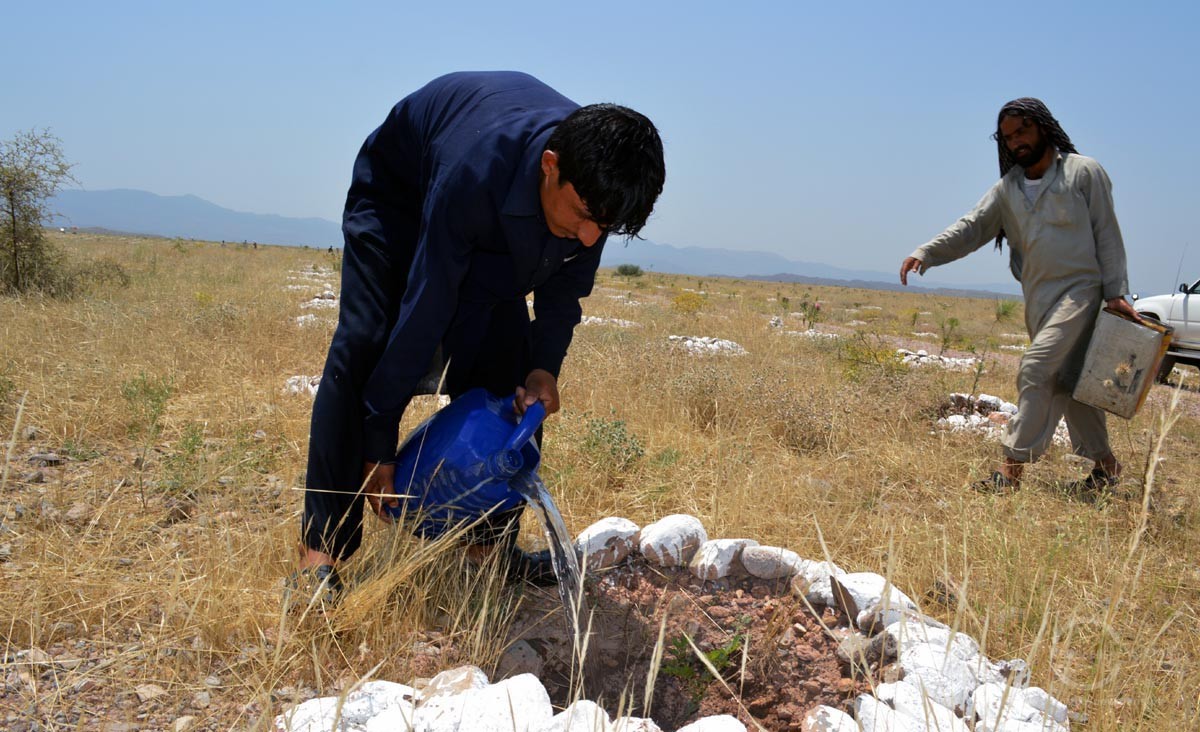
Peshawar: The rugged, barren landscape of Garhi Chandan village is an eye-sore. A vast dry landscape with low hills, it reflects the midday sun of June with an intensity that makes one want to run for shade. But on this day, the middle aged Hazrat Gul is upbeat, despite the heat and the light that makes his squint his eyes and cover his face with a hand.
“Soon, this will be a forest of trees,” he points at the open land stretching before him, a pool for shimmering heat, the sunlight beating against its hot, hard surface.
Gul is not alone in his optimism for a barren plain turned paradisaical with a surfeit of green. Men in this village on the outskirts of Peshawar nod in agreement when he speaks excitedly of the ambitious afforestation drive of the provincial government to plant a billion trees in Khyber Pakhtunkhwa province in five years.
Theirs is one of the villages selected for plantation of saplings, a billion of which will be planted across the province. On this day, the men of the community are out, along with the children, filling containers from a tanker to water the saplings planted in the village. It is an arduous undertaking, given the huge number of saplings.
Under the Green Growth Initiative launched by the Pakistan Tehreek e Insaaf government in KP in February this year, the provincial governments aims to plant a billion trees, increasing forest cover by 22 per cent, conducting bi-annual plantation drives and double the size of national parks over a period of five years.
The first phase of the Billion Trees Tsunami Afforestation Project in Khyber Pakhtunkhwa saw at least 11 million saplings of different species planted across the province. According to figures provided by the provincial forest department, only 20.3 percent or 1.510 million hectares of the total 7.4 million hectare area in KP is under forest, while 26 percent of the total area is rugged and barren.
The phase-1 of the project costing 886 million rupees has been sponsored through the Annual Development Programme of forest sector by the government of KP. The phase-2, estimated to cost 13448.364 million rupees, will be sourced through the provincial ADP and support from potential donors. Official data reveals that in ADP 2014-15, 486 million rupees had been allocated to the project by the provincial authorities while the rest of funds will be arranged through re-appropriation.
The project also aims to protect the existing forests and endangered species as people widely use forest wood for fuel. To make up for the attrition, fast growing tree species will be planted.The forestry authorities have chosen to plant saplings of polai, eucalyptus, tanap, sheesham, panata, cypress, and cedar trees. These trees are indigenous to this region and their uncontrolled – and in many cases illegal culling – has reduced their number to an alarming extent.
According to the Divisional Forest Officer Gulzar Khan, around 11 million saplings had been planted over 6,000 hectares in the first phase of the project. He said that 3.4 million saplings had been distributed among the people over the last one year.
Khan said that 250 hectares of land had been covered in Garhi Chandan village and during the next phase of the project they would plant more saplings over 25,000 kanals. He added that the species planted in Garhi Chandan included polai, shesham, chirpine, kikar, zizyphus, sanata, willow, poplar, amaltas, black bakain and diltoides.The species of plants have been planted in different regions of KP as per the climate conditions.
“With the help of village communities, 18 guards have been engaged on daily wages for the protection and conservation of natural regeneration in the state owned forests,”Khan told News Lens.
He said that the forest department lacked resources like manpower and transportation facilities but will try its best to make the project successful. “It’s a race against time,” he said, suggesting that the damage to flora in the province has been wide and need immediate steps to restore it.”Private nurseries are established at the union council and village level for the next phase plantation.”
During the first phase, the forest authorities established village development committees, joint forest committees and women organizations to plant saplings and protect trees. The process will continue till the end of project to provide assistance to communities in selection of areas for plantation, ensure protection from grazing, trampling,raise awareness and support to planned adaptation against climate change.
The PTI chairman Imran Khan had launched the Billion Trees Tsunami campaign in February 2014 under the umbrella of Green Growth Initiative of Khyber Pakhtunkhwa aimed at ‘greening the growth and development’ of the province. It is expected to increase the forest area from 17 per cent to 22 per cent.
However, the campaign, which was launched with great pomp and show, is progressing at a slow pace due to financial constraints and shortage of nurseries and manpower.
For the next phase of the project, officials said 6,000 million rupees were required but they had only received 600 million rupees – a mere 10 per cent of the total amount allocated.
Special assistant to the Chief Minister KP, Fazl – Ilahi said the campaign to grow one billion trees in four years was made without proper calculation because the forest department did not have its own nurseries to provide saplings for the campaign.
“It was an ambitious campaign, made without looking into realities,” he said.
Fazl-Ilahi said that the provincial government had also started a crackdown against timber Mafia in the province to protect the forests.
“It is important to launch large-scale afforestation programmes in order to protect the ecosystem and rural livelihood, ” said Divisional Forest Officer Gulzar Khan. “The campaign will provide the government an umbrella for the tree farming industry, prevent soil erosion and conserve natural resources. We will involve local communities to play an active role in the drive and create over 0.5 million employment opportunities. Schoolchildren will be asked to volunteer for the plantation drive.”
According to the forest department figures, as many as 20,000 private and government nurseries had been established throughout the province for the second phase to keep a steady supply of saplings to the growers. Some 19,9759000 plants will be raised in model nurseries and 6,63,25,000 plants in private nurseries for the project.
Regarding sustainability of the Green Growth Initiative, monitoring of tree plantation and care of saplings, an official of the project Ali Haider told News lens that they had established 400 village development committees (VDCs) under the supervision of Divisional Forest Officers (DFOs) to empower communities to take charge of their resources and mobilize communities to strengthen monitoring systems and watering schedule for new sapling.
“The sub divisional forest officer and the regional forest officer will supervise the work and would be responsible for carrying out the campaign in keeping with its vision,” said Haider.
Dr.Shafeeq ur Rehman, a professor at the Environmental Sciences Department University of Peshawar told New lens that it was an ambiguous target to plant billion trees in five years.
“It is not impossible but not an easy task,” he said.
Back in Garhi Chandan, Hazrat Gul eyes sparkle with the new hope of finding a source of income. “We are thankful to the forest department and the provincial government that planted millions of trees in this barren and rugged land.”



